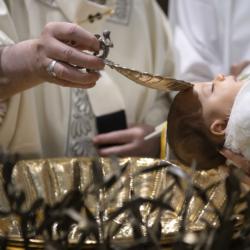The Little Flower and the Great Doctor: Àvila, Lisieux to hold events commemorating Carmelite saints
(OSV News) -- While millions of pilgrims hope to make their way to Rome for the Jubilee Year, Catholics in France and Spain will also have reason to stay in their countries as their respective churches prepare to commemorate two of the Catholic Church's most popular saints: Sts. Thérèse of Lisieux and Teresa of Ávila.
In France, the Sanctuary of St. Thérèse of Lisieux has planned a series of events throughout the Holy Year, culminating with the May 17 celebration to commemorate the 100th anniversary of the canonization of the famed French saint, affectionately known by devotees as The Little Flower.
Also in May, the relics of St. Teresa of Àvila will be opened to the public for veneration for the third time in over four centuries. The last time her relics were opened to the public was in 1914. The event follows a one-year study of the saint's relics by researchers who found her body incorrupt since her death in 1582.
Both saints are doctors of the church and members of the Carmelite order.
Dubbing the yearlong event as a "Theresian Year," the French sanctuary said the "story of Therese's life and posterity" inspired the spiritual and cultural events planned for the year "on the theme of joy in holiness."
The youngest of nine children, the saint was born in 1873 to Sts. Louis and Zélie Martin, who named her Marie-Françoise-Thérèse Martin. Like her older sisters, she joined the Carmelite sisters in 1888 at the age of 15 after receiving approval from her bishop and took the name Sister Thérèse of the Child Jesus and the Holy Face.
Her desire for holiness only increased during her time as a Carmelite sister. In her autobiography, "The Story of a Soul," she often compared herself to other saints and would often doubt she could ever obtain their degree of sanctity.
"You know it has ever been my desire to become a saint, but I have always felt, in comparing myself with the saints, that I am as far removed from them as the grain of sand, which the passerby tramples underfoot, is remote from the mountain whose summit is lost in the clouds," she wrote.
Nevertheless, it did not stop her from seeking out "a means to get to Heaven by a little way," in which the Carmelite nun hoped to obtain sanctity through small acts of holiness.
"You must practice the little virtues. This is sometimes difficult, but God never refuses the first grace—courage for self-conquest; and if the soul correspond to that grace, she at once finds herself in God’s sunlight," she wrote.
"I am not dying, I am entering life," she wrote to her missionary spiritual brother, Father M. Bellier, before she died in 1897 at the age of 24 of tuberculosis. Her last words were: "My God, I love you."
Due to the impact of St. Thérèse's autobiography, which was published one year after her death, the process of canonization was opened in 1914 and on May 17, 1925, she was canonized by Pope Pius XI.
In 1997, St. John Paul II declared her a doctor of the church. In his apostolic letter "Divini Amoris Scientia," (The Science of Divine Love), St. John Paul said that also Saint Thérèse did not have "a true and proper doctrinal corpus," her writings showed "a particular radiance of doctrine" that presented "a teaching of eminent quality."
The study of the remains of St. Teresa of Àvila, which was approved by the Vatican, was carried out by Italian doctors and scientists in August 2024.
According to Father Marco Chiesa, postulator general of the Order of Discalced Carmelites, who was present when the silver reliquary containing her relics was opened, the body was "in the same condition as when it was last opened in 1914."
Following the conclusion of the study, the Order of the Discalced Carmelites in Spain announced that the relics would be opened to the public for veneration from May 11-25 at the Basilica of the Annunciation in Alba de Tormes.
According to the local Spanish news site, Salamanca Al Día, the Carmelites said the upcoming event was "historic and unique" and would not happen again for a very long time.
"We hope that it will be a reason for pilgrims to come closer to Jesus Christ and the church, an evangelization for all visitors and a greater knowledge of St. Teresa of Jesus to enrich us all with the example of her life while invoking her intercession," the Carmelites said.
The exhibition, reported Salamanca Al Día, is part of a process of canonical recognition authorized by Pope Francis that began in 2022 and will conclude May 26, the day after the exhibition, and her remains will be returned to its tomb.
St. Teresa of Ávila played a key role during the Counter Reformation in encouraging the renewal of spiritual and monastic life and also reforming the Carmelite Order. Her call to a return to a more contemplative lifestyle inspired many, including St. John of the Cross, with whom she established the Discalced Carmelites.
Known for her theological writings on spiritual life, such as "The Interior Castle" and "The Way of Perfection," she was proclaimed a doctor of the church by St. Paul VI in 1970.
In a 2021 video message commemorating the 50th anniversary of the proclamation of St. Teresa of Ávila as a doctor of the church, Pope Francis said she "was outstanding in many ways."
"However, it should not be forgotten that her recognized relevance in these dimensions is nothing more than the consequence of what was important to her: her encounter with the Lord, her 'determined determination,' as she says, to persevere in union with him through prayer."
---Junno Arocho Esteves writes for OSV News from Malmö, Sweden.


















